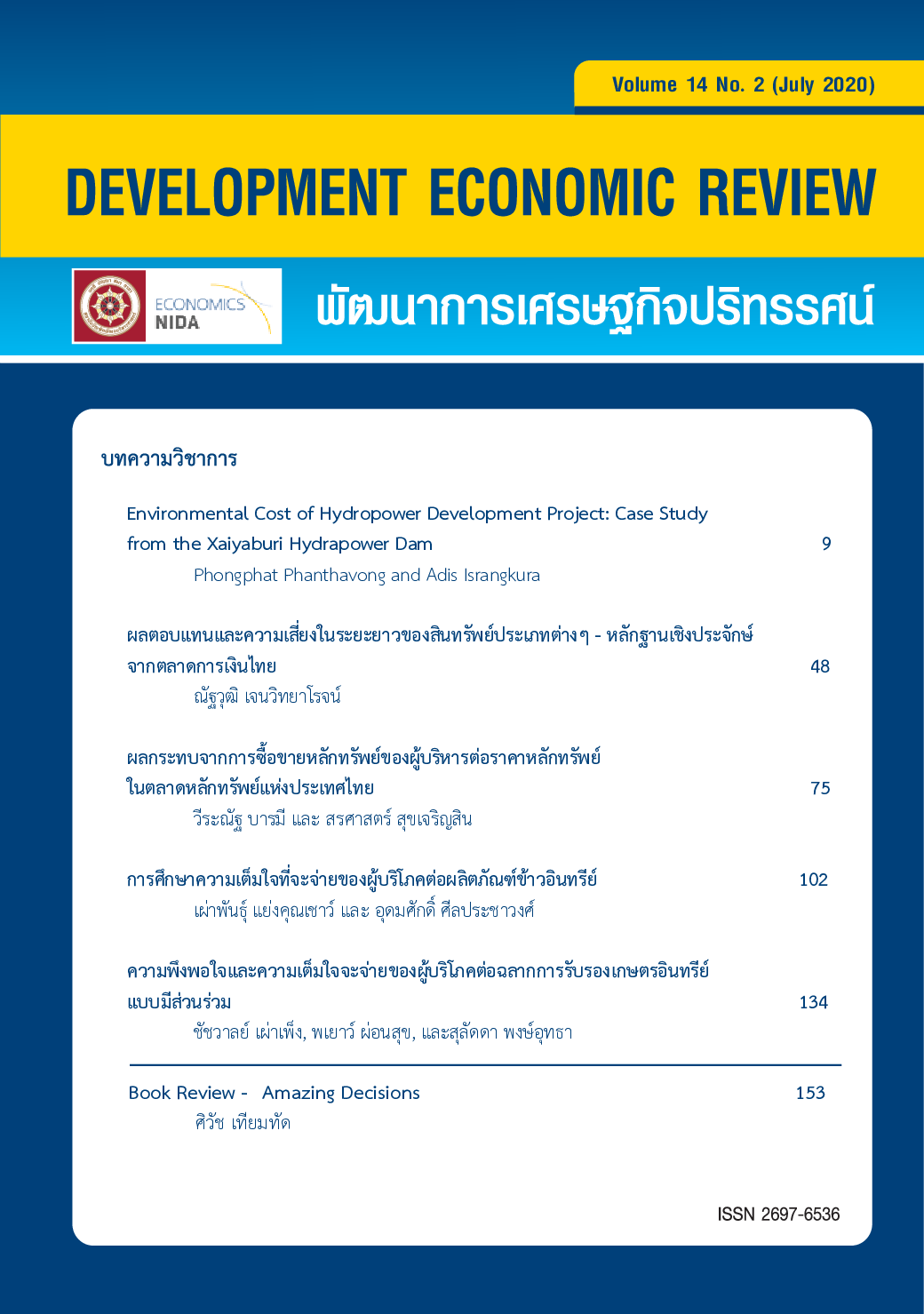ความพึงพอใจและความเต็มใจจะจ่ายของผู้บริโภคต่อฉลากการรับรองเกษตรอินทรีย์แบบมีส่วนร่วม
คำสำคัญ:
ระบบการรับรองเกษตรอินทรีย์แบบมีส่วนร่วม (PGS), เกษตรอินทรีย์, ความเต็มใจจะจ่ายบทคัดย่อ
ระบบการรับรองเกษตรอินทรีย์แบบมีส่วนร่ม (PGS) ถูกพัฒนาขึ้นเพื่อลดต้นทุนและเงื่อนไขของการรับรองมาตรฐานโดยบุคคลที่สามที่สร้างข้อจำกัดในการขอรับรองมาตรฐานเกษตรอินทรีย์ให้กับเกษตรกรรายย่อย การศึกษานี้มุ่งเน้นวิเคราะห์ความพึงพอใจและความเต็มใจจะจ่ายของผู้บริโภคต่อผักสดที่มีฉลาก PGS และการรับรองอื่น ๆ ในพื้นที่จังหวัดนครปฐมซึ่งเป็นตัวแทนตลาดท้องถิ่น เนื่องจากมีเครือข่าย PGS และกรุงเทพมหานครเป็นตัวแทนตลาดเมือง ผลการศึกษาด้วยวิธีการทดลองทางเลือก (CE) โดยใช้ผักกาดขาวปลีสดเป็นตัวแทนผักสดในการศึกษา พบว่า ผู้บริโภคมีความพึงพอใจและเต็มใจจะจ่ายส่วนเพิ่มหากผักกาดขาวปลีสดมีฉลากรับรองว่าปลอดภัยหรือเป็นเกษตรอินทรีย์ และให้ความสำคัญมากกับความสดของผัก โดยที่ผู้บริโภคในนครปฐมมีความเต็มใจจะจ่ายต่อผักกาดขาวปลีสดที่มีฉลาก PGS สูงกว่าผู้บโภคในกรุงเทพฯ ชี้ให้เห็นว่ PGS มีโอกาสในตลาดท้องถิ่นมากกว่าตลาดเมืองซึ่งมีความท้าทายสูงที่จะได้รับการสนับสนุนจากผู้บริโภค
เอกสารอ้างอิง
Athinuwat, D., Indramangala, J., Visantapong, S., Pornsirichaivatana, P., & Mettpranee, L. (2559). What is participatory guarantee system of organic standard?. Thai Journal of Science and Technology, 5(2), 119-134. (In thai)
สำนักงานมาตรฐานสินค้าเกษตรและอาหารแห่งชาติ. (2559). ข้อมูลการบริโภคอาหารของประเทศไทย. National Bureau of Agricultural Commodity and Food Standards. (2559). Food consumption data of Thailand. (In thai)
Akaichi, F., de Grauw, S., Darmon, P., & Revoredo-Giha, C. (2016). Does Fair Trade Compete with Carbon Footprint and Organic Attributes in the Eyes of Consumers? Results from a Pilot Study in Scotland, The Netherlands and France. Journal of Agricultural and Environmental Ethics, 29(6), 969-984.
Baker, G. A. (1999). Consumer preferences for Food Safety Attributes in Fresh Apples: Market Segments, Consumer Characteristics, and Marketing Opportunities. Journal of Agricultural and Resource Economics, 24(1), 80-97.
Bech, M., & Gyrd-Hansen, D. (2005). Effects coding in discrete choice experiments. Health economics, 14(10), 1079-1083.
Bliemer, M. C. J., & Rose, J. M. (2010). Construction of experimental designs for mixed logit models allowing for correlation across choice observations. Transportation Research Part B: Methodological, 44(6), 720-734.
Boccaletti, S., & Nardella, M. (2000). Consumer willingness to pay for pesticide-free fresh fruit and vegetables in Italy. The International Food and Agribusiness Management Review, 3(3), 297-310.
Carlsson, F., Frykblom, P., & Lagerkvist, C. J. (2005). Using cheap talk as a test of validity in choice experiments. Economics Letters, 89(2), 147-152.
ดาวน์โหลด
เผยแพร่แล้ว
ฉบับ
ประเภทบทความ
สัญญาอนุญาต
Copyright to published manuscripts becomes the property of the Graduate School of Development Economics, National Institute of Development Administration. Reproduction of all or part of a Development Economic Review (DER) article by anyone, excluding author(s), is prohibited, unless receiving our permission.


